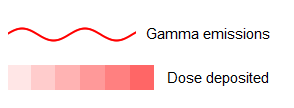2.9.3 Units related to Dose
The effect of gamma and other ionizing radiation on living tissue is more closely related to the amount of energy deposited in the tissues. Therefore, it is preferred to refer to the radiation impact on materials using the concept of dose, a measure of the energy deposited by radiation in a target (expressed as energy deposited per unit of mass, Joules per Kilogram). The SI unit is called Gray (Gy) and corresponds to absorption of 1 Joule of energy by a kilogram of matter (1 Gy = 1 J/kg). The deprecated centimeter–gram–second (CGS) unit for dose is the rad (1 rad = 0.01 Gy).
Equivalent dose is used to express the biological effect of radiation type R on human tissue or organ T. Equivalent dose HT,R is related to dose DT,R through the so called Radiation Quality Factor wR (representing the harmful effect of each type of radiation, 1 for x and gamma-rays, 3 for beta and 10 for alpha).
HT,R = wRDT,R
The SI unit of equivalent dose is the Sievert (Sv), and the CGS unit is rem (1 rem = 0.01 Sv). The different quantities and units are summarized in the Table below.
| Quantity | Symbol | Unit | Equivalents | Use/Conversion of older units |
|---|---|---|---|---|
| Dose | D | Gray (Gy) | Jkg-2=m2s-2 | absorbed dose. 1 rad=10-2Gy 1R=8.69x10-3Gy (in air) |
| Dose rate | D' | gray per second (Gy/s) | m2s-3 | gamma radiation field. 1 μR/h=8.69 nGy/h in air. |
| Dose equivalent | H | Sievert (Sv) | m2s-2 | biological effects of radiation. 1 rem=10-2 Sv |
| Photon dose equivalent rate | H'x | Sievert per second (Sv/s) | m2s-3 | dose equivalent per unit time |
| Equivalent dose | HT | Sievert (Sv) | m2s-2 | biological effects of radiation |
| Effective dose | E | Sievert (Sv) | m2s-2 | biological effects of radiation to man |
